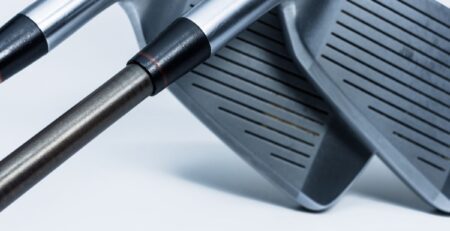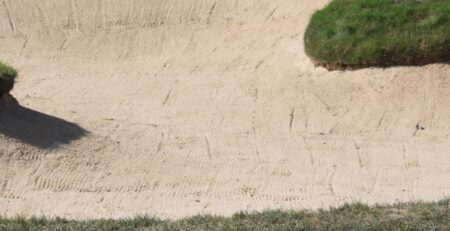Understanding Shaft Flex, Weight, and Material
Golf shafts, often overlooked, play a pivotal role in club performance and player suitability. The flex, weight, and material of a shaft directly influence ball flight, distance, and shot shape, making it crucial for golfers to understand these aspects when selecting the right clubs.
Shaft flex is a critical factor in golf club performance as it directly affects ball flight, distance, and shot shape. The flex of a golf shaft refers to its ability to bend during the swing, and different flex options cater to varying swing speeds and player profiles. Here are expanded details on shaft flex and its impact on golf shots:
Extra Stiff (X):
Extra stiff shafts are the stiffest option available and are typically designed for golfers with very high swing speeds. These shafts offer minimal flex and are designed to provide maximum stability and control. Golfers with extremely fast swings can benefit from extra stiff shafts as they promote lower ball flight, reduced spin, and increased accuracy. They require a powerful and aggressive swing to fully utilise their characteristics.
Stiff (S):
Stiff shafts are suitable for golfers with above-average swing speeds. They provide a balance between control and distance. Stiff shafts offer some flexibility to generate power while still providing stability and control for consistent ball striking. Golfers with moderate to high swing speeds often find that stiff shafts offer a good combination of distance and accuracy.
Regular (R):
Regular flex shafts are the most common and versatile option. They are suitable for a wide range of golfers, including those with moderate swing speeds. Regular flex shafts provide a balanced amount of flex and control, offering a blend of distance and accuracy. They are forgiving enough to help golfers with slightly slower swings achieve good ball flight while still providing enough stability for consistent shot performance.
Senior (A):
Senior flex shafts are designed for golfers with slower swing speeds, typically associated with seniors or those with less physical strength. These shafts offer more flexibility, allowing for greater energy transfer and increased distance. Senior flex shafts help maximise launch angles and provide a softer feel, aiding golfers in generating sufficient clubhead speed and optimising their ball flight.
Ladies (L):
Ladies flex shafts are specifically designed for golfers with slower swing speeds, typically women or juniors. These shafts are the most flexible option, providing maximum energy transfer and helping golfers achieve optimal launch conditions. Ladies flex shafts are designed to promote higher ball flight, increased distance, and improved shot trajectory for players with slower swing speeds.
Choosing the appropriate shaft flex depends on factors such as swing speed, tempo, and personal preference. It is essential to work with a professional club fitter or golf instructor who can assess your swing characteristics and recommend the most suitable flex for your game. Testing different flex options can help determine the ideal combination of distance, control, and shot shape for your individual swing. Selecting the right shaft flex can significantly impact your overall performance, allowing you to optimise your ball flight, maximise distance, and improve accuracy on the course.
Shaft Weight and Its Significance
The weight of a golf shaft plays a significant role in club performance, impacting factors such as control, accuracy, distance, and swing speed. Here’s an expanded explanation of the significance of shaft weight:
Heavier Shafts:
Heavier shafts generally promote greater control and accuracy. The additional weight can help stabilise the clubhead throughout the swing, providing a more consistent and controlled release. Golfers who have a fast swing tempo or a tendency to overpower the ball may benefit from the added stability of a heavier shaft. These shafts can help control ball flight and reduce dispersion, which is particularly important for players seeking accuracy and precision.
Lighter Shafts:
Lighter shafts are known for enhancing swing speed and potentially increasing distance. The reduced weight allows golfers to generate greater clubhead speed, translating into increased ball speed and potential distance gains. Golfers with slower swing speeds or those looking to maximise distance may find lighter shafts beneficial. Lighter shafts can also be advantageous for golfers who value a more effortless swing feel or who have difficulty generating ample clubhead speed with heavier shafts.
Player Factors:
When selecting the appropriate shaft weight, it is crucial to consider individual factors such as player strength, swing tempo, and personal preference. Stronger players who generate a lot of power may find that heavier shafts provide the control and stability they need. On the other hand, players with lower swing speeds or less physical strength may benefit from lighter shafts to help increase their clubhead speed and maximise distance potential. Swing tempo also influences the choice of shaft weight, as players with a smoother tempo may find lighter shafts more suitable, while those with a more aggressive tempo may prefer the additional stability of a heavier shaft.
Common Materials Used in Golf Shafts
Graphite Shafts
Graphite shafts are lightweight and known for their ability to enhance swing speed. They are made from carbon fibres woven together and bonded with resin. Graphite shafts reduce overall club weight, allowing golfers to generate higher clubhead speeds. This can result in increased distance and a softer feel. Graphite shafts also provide vibration dampening properties, reducing the impact felt in the hands and arms. These shafts are popular among many golfers, particularly those seeking distance gains or looking to minimise the strain on their bodies.
Steel Shafts
Steel shafts are typically heavier and provide a solid, stable feel during the swing. They are made from high-quality steel and offer excellent control and accuracy. Steel shafts are renowned for their consistency and durability, making them a preferred choice for many professional golfers and players who prioritise precision over distance. Steel shafts are generally less expensive compared to graphite shafts and offer a firmer feel.
Composite Shafts
Composite shafts combine different materials, typically blending graphite and steel, to achieve a balance between the benefits of both. These shafts aim to provide the stability and control of steel with the lighter weight and increased swing speed potential of graphite. Composite shafts offer versatility, allowing golfers to optimise their performance based on their swing characteristics and preferences.
Torque and Kick Point Impact
Torque and kick point can significantly influence ball flight and shot trajectory. Lower torque shafts reduce twisting and offer more control, ideal for high swing speed players. The kick point, the flex point of the shaft, can dictate ball flight— a high kick point promotes a lower trajectory, while a low kick point encourages a higher trajectory.
The Fitting Process
The fitting process is an essential step in finding the right golf shaft for an individual golfer. It involves using launch monitors, swing analysis tools, and the expertise of a professional club fitter to identify the optimal shaft characteristics that align with the player’s unique swing dynamics. Here’s an expanded explanation of the fitting process and the benefits of upgrading golf shafts:
The Fitting Process:
- Swing Analysis: The fitting process begins with a comprehensive analysis of the golfer’s swing. This includes measuring swing speed, tempo, release point, and other key swing parameters. Launch monitors and radar technology provide valuable data on ball flight characteristics, such as launch angle, spin rate, and dispersion.
- Player Assessment: Understanding the player’s goals, preferences, and typical playing conditions is crucial. Factors such as skill level, desired ball flight, shot shape, and the course conditions they often encounter are taken into account. A player’s physical characteristics, such as height, arm length, and strength, are also considered to ensure a proper fit.
- Shaft Selection: Based on the swing analysis and player assessment, the club fitter recommends a range of shaft options that best suit the player’s needs. This includes considering factors such as flex, weight, torque, and bend profile. Different combinations of these characteristics can significantly impact the performance and feel of the club.
- Trial and Feedback: The golfer tests different shaft options on the driving range or in a hitting bay to experience the performance differences first-hand. The club fitter carefully monitors the results, gathers feedback, and makes adjustments to refine the fitting process further. It may involve trying different shaft flexes, weights, or profiles to find the ideal combination that optimises performance and feel.
- Finalising the Fit: Once the golfer and club fitter have identified the best-performing shaft, adjustments can be made to other club specifications, such as loft, lie angle, and grip size, to ensure the overall club setup complements the selected shaft. This ensures the golfer’s equipment is fine-tuned to their swing and maximises their potential on the course.
Benefits of Upgrading Golf Shafts
Improved Distance:
The right shaft can help golfers optimise their launch conditions, leading to increased ball speed and distance. Matching the shaft’s characteristics to a player’s swing speed, tempo, and release can enhance energy transfer and generate maximum power. Upgrading to a shaft that better suits the player’s swing mechanics can unlock untapped distance potential.
Enhanced Accuracy and Consistency:
An appropriately fitted golf shaft can promote better accuracy and consistency. It helps golfers achieve optimal launch angles, control spin rates, and deliver more consistent face angles at impact. This leads to tighter shot dispersion and improved shot control, allowing golfers to hit their intended targets more consistently.
Improved Feel and Feedback:
Upgrading golf shafts can enhance the feel and feedback during the swing. The right shaft can provide a better sense of clubhead position, stability, and impact sensation. This allows golfers to develop a more connected and responsive relationship with the club, leading to improved shot quality and overall confidence.
Personalised Performance:
Every golfer has a unique swing, and upgrading golf shafts allows for a more personalised equipment setup. By selecting the right shaft characteristics, players can optimise their club’s performance to suit their specific swing dynamics, resulting in a more enjoyable and successful golfing experience.
Adaptability to Playing Conditions: Different golf shafts may perform better in specific playing conditions. For example, players may benefit from a higher launching, lower spinning shaft for windy conditions or a lower launching, higher spinning shaft for firm fairways. Upgrading shafts allows golfers to adapt their equipment to various course and weather conditions for optimal performance.
Tips for Shaft Maintenance
Maintaining golf shafts is essential for preserving their performance and longevity. Here are some expanded tips for proper shaft maintenance:
- Regular Inspection: Regularly inspect your golf shafts for any signs of damage, including cracks, dents, or splintering. Check the entire length of the shaft, paying close attention to areas near the clubhead and grip. If you notice any damage, it’s important to address it promptly to prevent further deterioration and potential performance issues.
- Cleaning: Regular cleaning helps remove dirt, debris, and oils that can accumulate on the shaft’s surface. Use a soft cloth or sponge dampened with mild soapy water to gently clean the shaft. Avoid using harsh chemicals or abrasive materials that can scratch or damage the surface. After cleaning, wipe the shaft dry with a clean cloth.
- Grip Maintenance: While not directly related to the shaft, the grip plays a significant role in your connection to the club. Keep the grip clean by wiping it down with a damp cloth and mild soapy water. Additionally, use a grip brush or a soft-bristle toothbrush to remove any dirt or debris that may have accumulated in the grip’s texture. Maintaining a clean grip ensures a secure and comfortable hold on the club.
- Storage: Proper storage is crucial to prevent damage to golf shafts. Store your clubs in a dry, moderate temperature environment, away from excessive heat, cold, or humidity. Avoid leaving clubs in a car trunk or a hot/cold area for an extended period, as extreme temperature fluctuations can affect the integrity of the shaft material. Utilise a golf bag or rack that provides adequate protection and support to prevent any unnecessary stress or bending of the shafts.
- Shaft Protection: Consider using headcovers on your clubs, especially for drivers and fairway woods, to protect the shafts from accidental impacts and scratches during transportation or storage. Additionally, be mindful when placing your clubs in the bag, ensuring that they are secured and separated to prevent any potential rubbing or clattering that could cause damage.
- Professional Inspection and Repair: If you have any concerns about the condition of your golf shafts or suspect damage beyond what you can address yourself, it is advisable to consult a professional club fitter or repair specialist. They can thoroughly inspect the shafts, identify any issues, and provide appropriate repair or replacement options.
- Understanding the science behind golf shafts can significantly enhance a player’s performance. From flex and weight to material, torque, and kick point, these factors collectively influence a club’s feel and behaviour. Through proper fitting and shaft care, players can optimise their game and anticipate future advancements in golf shaft technology.











